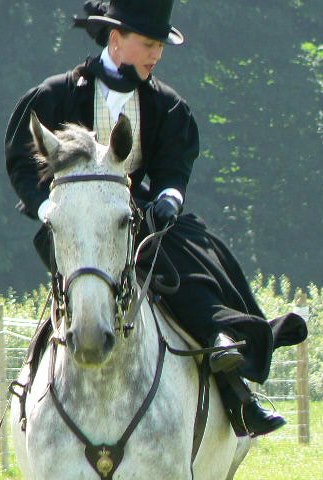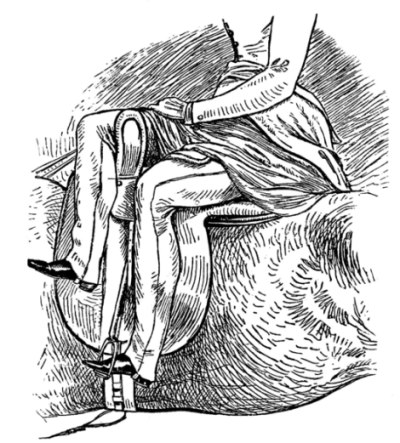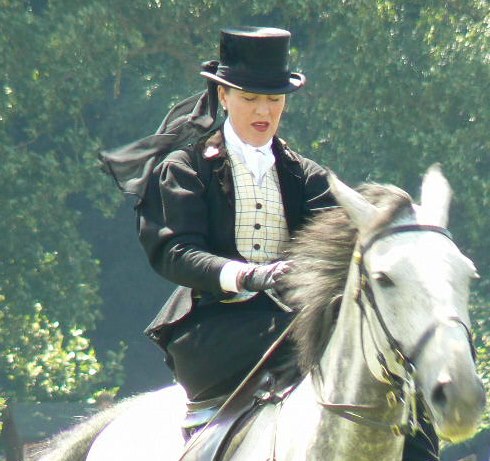侧身骑马

对于女性来说,坐在马边可以追溯到古代。 主要是男人骑马,女性只是乘客,坐在男人后面,要么搂着男人的腰,要么坐在一个小垫子上,或者坐在小腿上。 这部分是由于她们的裙子又长又重;跨骑是不现实的。 另外,骑在马边被认为是为了保护女性的贞洁。
女士骑马不雅的想法可以追溯到1382年,当时波西米亚的安妮公主在嫁给理查德二世的路上骑着马横穿欧洲。 很快,任何女士骑马被认为是粗俗的。
到了中世纪晚期,很明显,要想让女士们骑马,就必须专门设计一个马鞍,让女士们能够控制马匹,但仍要保持适当的体面。
最早的功能性侧鞍是一种类似椅子的结构,妇女侧身坐在马背上,双脚放在脚垫上,设计于14世纪末。 据说凯瑟琳-德-美第奇在16世纪开发了一种更实用的设计。 她没有把双脚并排放在脚垫上,而是把右腿放在马鞍的鞍座上,以显示这样的骑行方式让骑手对马匹的控制力更强,甚至可以让骑手安全地进行小跑和快跑。

高速骑行,坐在一边
随着时间的推移,对马鞍进行了进一步的调整,但在19世纪30年代引入的第二个鞍座才是革命性的。 这个额外的鞍座使妇女在侧骑时既能增加安全感,又能获得更多的活动自由。 这使她们能够在奔跑中保持稳定,甚至在打猎和跳马时跳过栅栏,同时仍然符合预期。适当和谦虚的水平。
事实上,直到19世纪50年代,对于贵族和上层社会的女孩和妇女来说,骑马和跳舞是唯一被社会接受的体育活动。

侧身骑马时双腿的位置示意图
到了维多利亚时代,女性骑马的姿势与今天非常相似。 骑手坐在马背上,右臀向后,让肩膀落在一起。 右腿放在马鞍的前面,左腿弯曲,放在马鞍上,脚放在拖鞋马镫里。
至于骑马服,直到16世纪末才出现了专门为骑马而设计的习惯。 在此之前,骑马时穿的是普通的日常服装。 第一条 "安全裙 "是在1875年发明的,以帮助防止妇女在摔倒时被裙子抓住并被马拖走的可怕事故。 这些安全裙沿接缝处扣住,并且后来发展成围裙,扣在腰间,刚好覆盖腿部(腿部被马裤包裹)。
See_also: 二战时间线--1942年在20世纪初,社会上开始接受妇女在穿开叉裙或马裤的情况下骑马,而侧鞍开始不再流行。 妇女选举权的兴起也起到了一定的作用;对女权主义者来说,侧鞍骑马是男性统治的象征。 因此,到1930年,侧鞍骑马已经完全被接受,成为妇女的首选骑法。

然而,在过去几年中,侧鞍骑马的艺术得到了复兴。 你可以称之为 "玛丽夫人 "效应:《唐顿庄园》中虚构的女主人公在一旁打猎,似乎激发了女性骑手的新兴趣。 在全国各地的展示会上,可以看到诸如 "飞狐 "和 "A Bit on the Side "等团体在骑马。 事实上,一个新的英国侧鞍骑马高跃升记录刚刚由Michaela Bowling创造--6英尺3英寸!
See_also: 格林斯泰德教堂--世界上最古老的木制教堂
